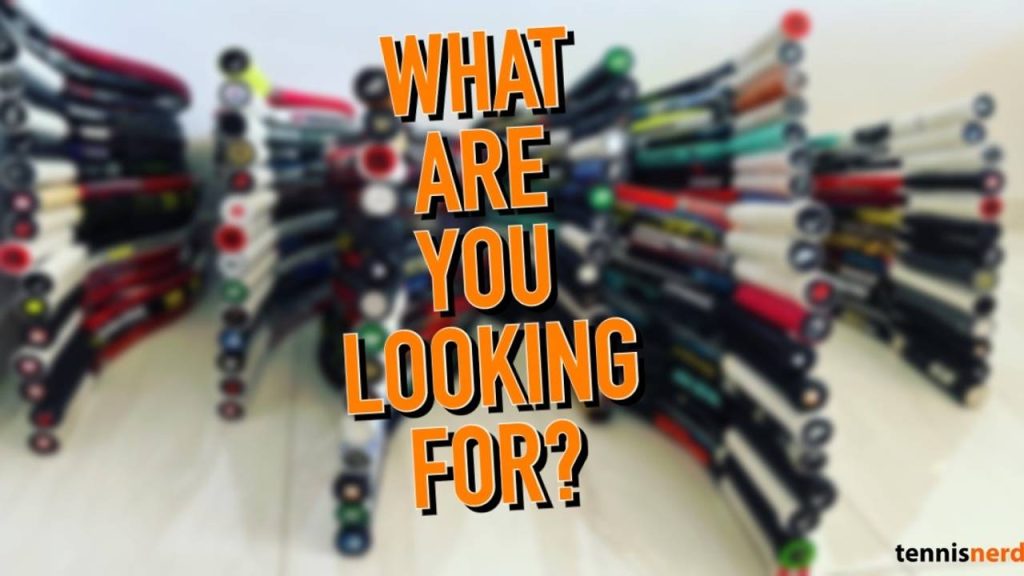There are no perfect racquets out there. You need to compromise on some things and prioritize others. What are you looking for in a racquet?
You can take a look at our Recommended Racquets and Recommended Strings or our current favorite racquets to get straight to the point.
Most players these days want more power and forgiveness. But at the same time, we see a rise in tennis elbow stemming from playing with stiff racquets and strings.
Your choice of racquet and string is deeply personal. What you like and play well with is entirely up to you. Yes, you can and should listen to advice from informed people. But the decision is ultimately yours. Some players won’t need help with power; others will. Some are obsessed with how a racquet feels; others are not.
I think the racquet needs to feel right to you, though. The ultimate goal should be to get something that feels like “home” whenever you pick it up. But “home” looks different to all of us. Some players like “crisp,” some like “plush,” others prefer muted, while many love getting feedback from their racquet.
Feel
Racquets have been getting stiffer over the years, meaning they don’t flex or bend much when they make contact with the ball. Instead, they return all that power to the ball, sending it over faster. That sounds all well and good if you want more power on your shots, but the downside with many stiffer frames is that the quicker vibrations they create go down to the player’s arm. It can lead to injuries like tennis elbow, which many tennis players suffer from on the pro level and recreational players.
Racquet manufacturers (you can find pretty much all of them at Tennis Warehouse) have tried to reduce vibrations from stiff racquets by incorporating dampening materials in the layup. The idea is to filter out the “bad vibrations” and, hopefully, keep some of the good ones.
The so-called “good” vibrations are the feedback you get from hitting the ball. If the racquet becomes overly dampened, you lack that feedback, making it difficult to feel and control the ball.
A few examples of dampening materials used in recent years are Countervail (Wilson), Vibration Dampening Mesh (Yonex), and Cortex Pure Feel (Babolat). Many companies use some kind of foam inside the racquet to dampen vibrations but then call it different names for marketing purposes.
Some players enjoy a powerful, dampened, and muted feel, while others prefer a more “connected” racquet with less power and a lower flex rating. That type of racquet was more prevalent years ago, while stiffer racquets are more of the norm today.
There is no right and wrong here, but it’s usually best to experiment and test a few different racquets to understand what feels suitable for you and your game.
Maneuverability or forgiveness
Racquets come in different head sizes. You can choose a smaller head-size racquet that is easier to manuever and cuts through the air more efficiently. Or you can go for a bigger head size, which will usually give you a more significant sweet spot and more margin for error.
Spin or control
String patterns influence the launch angle of the ball. A tighter string pattern like 18×20, for example, will give you a lower trajectory of the ball, which will generally allow you to control flatter shots better. But players who hit with a lot of topspin usually would like the racquet to give them more bite on the ball and a higher launch angle. This is accomplished by a more open string pattern (typically 16×19), which will grab the ball and add spin, but it might also send flatter shots long. A racquet focused on accelerating top spin and launch angle (check out our terminology for more info) is called a spin racquet.
Stability or speed
The heavier a racquet is, the more stable it is. The problem when you add weight to a racquet is that it becomes heavier to swing. The racquet’s weight will create a heavier ball, but you won’t be able to swing the racquet as fast. If you like to hit the ball fast and generate a lot of racquet head speed, you likely prefer a lower weight. But if you have a more dependable swing rhythm and you still want to hit a heavy ball, a heavier racquet is more suitable for you.
You can always add weight to a racquet with lead or tungsten tape, which is basic customization, so starting with a lighter weight and customizing it to be heavier as you want to add more stability or plow-through is a good idea.

